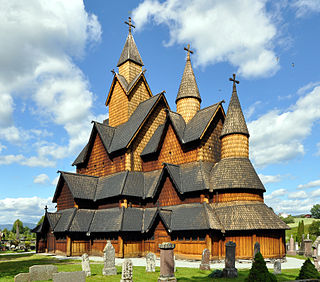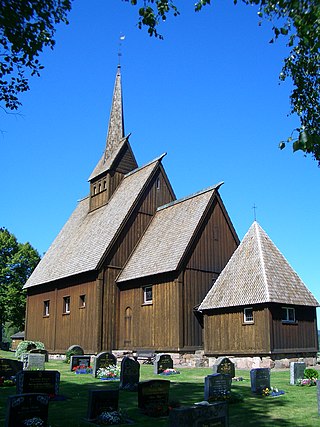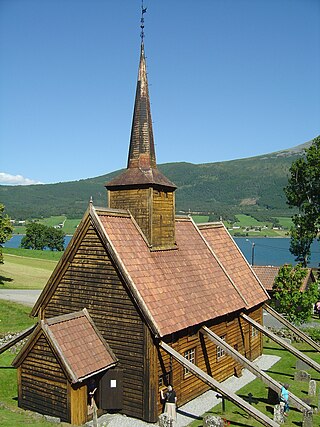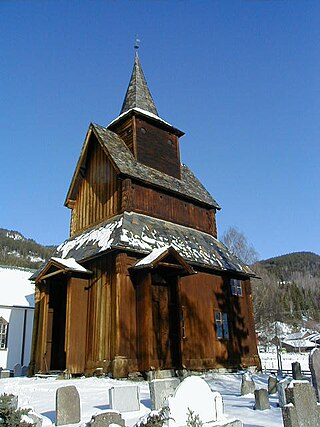
Flesberg Stave Church (Nynorsk : Flesberg stavkyrkje) is a stave church located at Flesberg in Buskerud county, Norway. [1] [2]

Flesberg Stave Church (Nynorsk : Flesberg stavkyrkje) is a stave church located at Flesberg in Buskerud county, Norway. [1] [2]


Written sources mention the church the first time in 1359, but it was probably built in the latter half of the 1100s or the first half of the 1200s. The church was originally a single nave church (type B) with four free-standing internal posts bearing a raised central roof, surrounded by an ambulatory or aisles on all four sides. It had a narrower chancel, also with a raised central roof, and a semicircular apse. It was surrounded by a gallery loosely connected to the plank walls. [3]
In 1735, the chancel and apse, as well as the east wall of the nave, were removed. The nave was extended eastwards and two transepts were added, making a cruciform plan. The additions were built in horizontal log construction with notched corners. Portal planks are decorated with carved vines and animal ornamentation. Since few parts of the stave church are preserved, there are only scant remnants of its original decor. Of the original stave church, only three outer walls survived, as the internal posts and the raised roof were eliminated. [4]
The churchyard is fenced with slate brought from Haukeli farm on the west bank of the Lågen River. Some slates have iron rings affixed; these rings were used to tether horses during service. Each farmer had a designated ring for his horse (the oldest dated ring from 1661). The idiosyncratic stone fence is shown on a 1701 painting (the oldest existing painting of a stave church). [5] [6]
The interior of the church is characterized by the reconstruction of 1735. There are a few remains of medieval furnishings. There is a decorated lion and a lionhead that also originates in the Middle Ages. Underneath the whitewashed walls, decorative paintings from the Middle Ages were uncovered. [7] [8]

Rollag is a municipality in Buskerud county, Norway. It is part of the traditional region of Numedal. The administrative centre of the municipality is the village of Rollag, although the most populated area in the municipality is Veggli. Rollag is bordered in the north by Nore og Uvdal, in the east by Sigdal, in the south by Flesberg, and in the west by Tinn in Telemark.

A stave church is a medieval wooden Christian church building once common in north-western Europe. The name derives from the building's structure of post and lintel construction, a type of timber framing where the load-bearing ore-pine posts are called stafr in Old Norse. Two related church building types also named for their structural elements, the post church and palisade church, are often called 'stave churches'.

Heddal Stave Church is a parish church of the Church of Norway in Notodden Municipality in Telemark county, Norway. It is located in the village of Heddal. It is the church for the Heddal parish which is part of the Øvre Telemark prosti in the Diocese of Agder og Telemark. The wooden, triple nave stave church was built in a long church design around the year 1200 using plans drawn up by an unknown architect. The church seats about 180 people.

Vågå Church is a historic stave church. It is a parish church of the Church of Norway in Vågå Municipality in Innlandet county, Norway. It is located in the village of Vågåmo. It is the church for the Vågå parish which is part of the Nord-Gudbrandsdal prosti (deanery) in the Diocese of Hamar. The brown, wooden church was built in a cruciform design in 1627 by the architect Werner Olsen. The church seats about 250 people.

Grip Stave Church is a historic parish church of the Church of Norway in Kristiansund Municipality in Møre og Romsdal county, Norway. It is located in the now-abandoned fishing village of Grip on the small island of Grip about 14 kilometres (8.7 mi) northwest of the town of Kristiansund. It is an annex church for the Kristiansund parish which is part of the Ytre Nordmøre prosti (deanery) in the Diocese of Møre. The white, wooden church was built in a rectangular stave church style in 1470 by an unknown architect.

Høyjord Stave Church is a parish church of the Church of Norway in Sandefjord Municipality in Vestfold county, Norway. It is located in the village of Høyjord. It is the church for the Høyjord parish which is part of the Sandefjord prosti (deanery) in the Diocese of Tunsberg. The brown, wooden church was built in a stave church design during the late 12th century using plans drawn up by an unknown architect. The church seats about 150 people.

Eidsborg Stave Church is a parish church of the Church of Norway in Tokke Municipality in Telemark county, Norway. It is located in the village of Eidsborg. It is one of the churches for the Eidsborg, Mo, og Skafså parish which is part of the Øvre Telemark prosti (deanery) in the Diocese of Agder og Telemark. The brown, wooden stave church was built in a long church design around the year 1250 using plans drawn up by an unknown architect. The church seats about 70 people.

Uvdal Stave Church is situated at Uvdal in the valley Numedal in Nore og Uvdal in Buskerud, Norway. The stave church was originally constructed just after the year 1168, which is known through dendrochronological dating of the ore-pine used in the construction. The logs were not completely dry when the construction took place.

Nore Stave Church is a stave church located at Nore in Nore og Uvdal kommune in Buskerud county, Norway.

Røldal Stave Church is a parish church of the Church of Norway in Ullensvang Municipality in Vestland county, Norway. It is located in the village of Røldal. It is the church for the Røldal parish which is part of the Hardanger og Voss prosti (deanery) in the Diocese of Bjørgvin. The brown, wooden stave church was built in around the year 1250 using designs by an unknown architect. The church seats about 130 people and is built in a long church design. The church is a preserved historic museum, but it is still a regularly-used parish church that holds regularly scheduled worship services twice a month.

Rollag Stave Church is a stave church in the municipality of Rollag in Buskerud county, Norway. The church is located a few kilometres north of the centre of the village of Rollag.

Lomen Stave Church is a stave church of the Church of Norway in Vestre Slidre Municipality in Innlandet county, Norway. It is located in the village of Lomen. It was formerly the church for the Lomen parish which is part of the Valdres prosti (deanery) in the Diocese of Hamar. The brown, wooden church was built in a long church design around the year 1192 using plans drawn up by an unknown architect. The church seats about 150 people.

Gol Stave Church is a 12th century stave church originally from Gol in the traditional region of Hallingdal in Buskerud county, Norway. The reconstructed church is now a museum and is now located in the Norwegian Museum of Cultural History at Bygdøy in Oslo, Norway.

Kvernes Stave Church is a former parish church of the Church of Norway in Averøy Municipality in Møre og Romsdal county, Norway. The old church sits along the Kvernesfjorden in the village of Kvernes, just to the north of the Kvernes Church, the present church for the parish. The white, wooden church was built in a rectangular stave church style sometime during the first half of the 14th century. The church seats about 200 people.

Ringebu Stave Church is a parish church of the Church of Norway in Ringebu Municipality in Innlandet county, Norway. It is located in the village of Ringebu in the Gudbrandsdalen valley. It is the church for the Ringebu parish which is part of the Sør-Gudbrandsdal prosti (deanery) in the Diocese of Hamar. The brown, wooden church was built in a stave church design around the year 1220 using plans drawn up by an unknown architect. The church seats about 300 people.

Rødven Stave Church is a former parish church of the Church of Norway in Rauma Municipality in Møre og Romsdal county, Norway. The stave church is located in the village of Rødven. It was a church in the Eid og Holm parish which is part of the Indre Romsdal prosti (deanery) in the Diocese of Møre. The brown, wooden church was built in a long church design during the 12th century by an unknown architect. The church seats about 100 people.

Torpo Stave Church is a stave church located in Torpo, a small village in Ål municipality in Buskerud county, Norway. Torpo is located along Norwegian National Road 7, the Norwegian national road which runs between Oslo and Bergen.

Hedalen Stave Church is a parish church of the Church of Norway in Sør-Aurdal Municipality in Innlandet county, Norway. The stave church is located in the Hedalen valley. It is the church for the Hedalen parish which is part of the Valdres prosti (deanery) in the Diocese of Hamar. The brown, wooden stave church was built in a cruciform design around the year 1160 using plans drawn up by an unknown architect. The church seats about 210 people.

Nore is a village in the municipality of Nore og Uvdal in the county of Buskerud, Norway. It is located in the traditional region of Numedal.

Hurum Church is a medieval stone church in Hurum, Norway. It was constructed in the 12th century. The church was damaged by fire in 1686, and rebuilt with a baroque interior. Next to the church, the Huitfeldt-family built a wooden funeral chapel in the second half of the 17th century. A new stone chapel was built in 1750, and contains the remains of the naval commander Iver Huitfeldt.